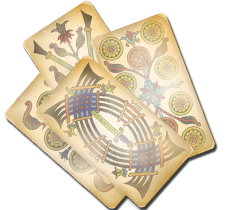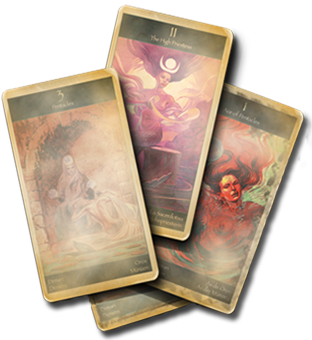The Tarot

Are you familiar with the Tarot? (pronounced Ta-row) For those of you that have had a Tarot reading, are you curious about the history and how the deck ‘works’? Or, are you simply concerned with the messages the deck holds for you?
A Tarot reading is quite interesting and amazingly accurate as many of you know. For those of you that aren't familiar with the Tarot, it can be a fascinating new adventure.
Let me start by explaining the Tarot. A Tarot deck is made up of 78 cards, which are separated into two sections. The first section is made up of 22 Major Arcana or ‘trump cards’ (or royal picture cards), and each is numbered from 0-22.
The other 56 cards make up the Minor Arcana (called ‘pip’ cards) and are separated into four suits: Cups, Pentacles (or Coins), Swords, and Staffs (or Wands). Each suit is also numbered beginning with an ‘Ace’ thru 10. Each suit also contains four court cards- a Page, a Knight, a Queen and a King.
The word Arcana is the ancient word meaning ‘secret’. In the early use of the Tarot only the Major Arcana had pictures and they were the only ones consulted for divination. The Minor Arcana showed only the correct number of symbols from each suit. Even today a reader who is just starting out will begin learning with the Major Arcana only. As there are 78 cards and the meanings are so different it would be very confusing and difficult to try teaching them all at one time.
The word tarot itself is the French adaptation for the Italian word ‘Tarocco’ the name of an old card game. There are several other theories on the meaning of the word Tarot, for instance:
- Tora - Hebrew for law
- Taru - Sanskrit meaning deck of cards
- Ta Rosh - Egyptian meaning the royal way
- Rota - Latin meaning wheel
So just by the combination of meanings we have the deck pretty well described.
Many cultures have laid claim to the founding of the Tarot, yet no one knows the exact origin. From the Cabbala, to Egyptian initiation rites, to Tantra and the explanation that the Tarot was mans earliest book, mystery surrounds its origin.
- One theory is that around 1200 a group of scholars got together in Morocco to establish a universal symbolic language.
- Some believed that Gypsies brought the cards to Europe in the 14th century after fleeing persecution in India.
- In 1781 a man named Antoine de Gebelin, who had studied occult teachings extensively, gave a convincing case that Tarot originated from "The Book of Thoth" an important universal book of knowledge that was saved from the burning temples of Egypt. It is said that Thoth was the inventor of magic and possibly the inventor of speech and writing, and that the Tarot was created by him for his magician disciples to follow.
- In the mid 19th century a man named Eliphas Levi further supported de Gebelins idea and extended it into a system continuing to use Egyptian imagery and linking it to Cabbala, an enormously intricate Jewish system of meditation, mysticism, and universal study.
The connections between the Cabbala and the Tarot are quite interesting. Cabbala draws from mediation on the 22 letters of the Hebrew alphabet and teaches that God created the cosmos in four steps. Each of the letters is a pathway connecting the 10 spheres in the Tree of Life of the Jewish Cabbala. The 22 trump cards of the Tarot each symbolizes a spiritual journey every man must follow in order to achieve higher states of awareness and understanding. We can see the Tarot as a systematic expression of the Cabbala!
At the turn of the century a mysterious group of mystics called the ‘Order of the Golden Dawn’ took these beliefs even further and linked the cards to magical practices and astrology. Although the group was only in existence for a short time, its influences were strong and continue today.
Members of the Golden Dawn went on to create two of the most popular decks on the 20th century. William Rider and Dr. Arthur Edward Waite created the Rider-Waite deck along with artist Pamela Colman-Smith. This deck is without a doubt the most popular and is used today by the majority of Tarot readers. The art work of this deck has inspired most of the contemporary decks today. The Rider-Waite deck brought a transformation in the appearance of the Tarot with each card depicting a scene or telling a story, not just appearing as a number or symbol card, thus allowing readers to interpret the events and actions on the card. I think that is one reason the deck gained such popularity.
The second deck with its elegant drawings by artist Lady Frieda Harris is the Allister Crowley ‘Book of Thoth’ deck and although it is not as available as the Rider-Waite, it is still popular and still in use.
Whatever we read or believe, there is no factual evidence to 100% supports any one claim of where Tarot began and whether it was first meant as divination tool centuries ago or an elaborate card game. Whichever we believe, one thing that can't be overlooked is that interest in the Tarot continues to soar. Many today, myself included, are drawn to the Tarot not only for their magical use, but for the astounding art work portrayed in each deck.
My personal favorite is the Tarot of the Moon Garden illustrated by Karen Marie Sweikhardi. The deck depicts an enchanted moon garden, filled with unicorns, fairies and flowers, and castles. Kipling West's "Halloween" deck is a festive, fun deck that guides us on a trick or treat mission to find what universe has waiting for us. Take a journey through the Looking Glass with the Alice In Wonderland deck and let your inner child play. Pietro Alligo's Tarot of the Mermaids opens our imagination to a magical world that resides under the sea. Next time you come across a tarot deck. open yourself to the gift of art held within each deck.
Note: Maya has a collection of over 22 decks of Tarot cards. Last summer many of her decks were part of an exhibit at the Valley Cottage Library.




